USB Fast Charging details introduction
Time:2023-09-18
Views:419
USB Fast Charging details introduction
With the rise of smartphones, the functions are gradually powerful and the battery capacity is gradually increasing. The original USB charging capacity cannot meet the existing demand for charging power and charging time.
Nowadays, smartphones and other USB devices are basically equipped with fast charging technology. Generally, for USB charging power more than 10W (that is, 5V 2A) to be called fast charging.
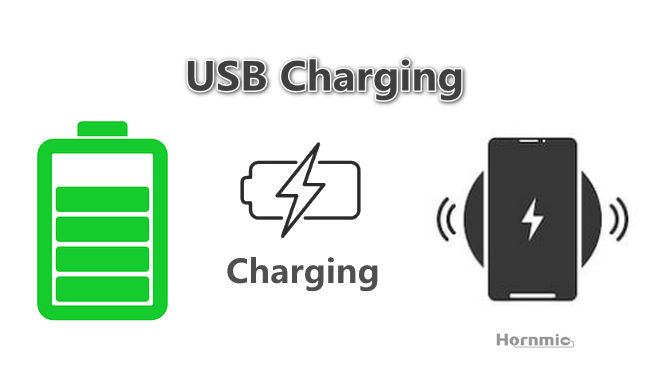
At the beginning, cell phone batteries are not large, this time the default 5V 0.5A USB interface can meet the needs of charging; but when the emergence of smart phones, due to the substantial thirst for performance led to a rise in power consumption, 0.5A can no longer meet the needs; so the definition of an enhanced USB charging identification standard: BC 1.2. it will charge the maximum current expansion to 5V 1.5A.
But around 2013, smartphones with more than 3000 mAh appeared, and by this time even 5V 1.5A could not meet the demand, so it was extended to 5V 2A again.
Who decides the current magnitude?
Cell phone charging current is controlled by the phone, not the charger. That is to say, the phone is the dam, the charger is just the reservoir, the phone will intelligently detect the load capacity of the charger, the charger power is good quality, the phone will allow the charger to load higher current; charger design output current is too small, then the phone will also limit the current to charge itself.
This is why we have to buy a high-power charger, for example, a cell phone supports a maximum of 5V 1.5A input, you buy a 5V 1A charger, it will lead to the phone can only be charged with 5V 1A, not only slow charging speed, and because the charger has been working at full load serious heat; on the contrary, you buy a 5V2A charging head, the phone will control only input 1.5A current, the charger The load is lower and there is plenty of spare capacity.
The iPhone 6/Plus support up to 5V 1.5A/2A charging respectively, but Apple‘s standard charger is only 5V 1A. It doesn‘t really matter for the iPhone 6 with 1800 mAh battery, but it‘s too slow for the iPhone 6 Plus with nearly 3000 mAh battery!

In actual tests, the iPhone 6 Plus can reach a peak charging current of 5V 1.9A using the iPad charger for one reason to save cost.
Various power charging heads charging time curve for iPhone X:
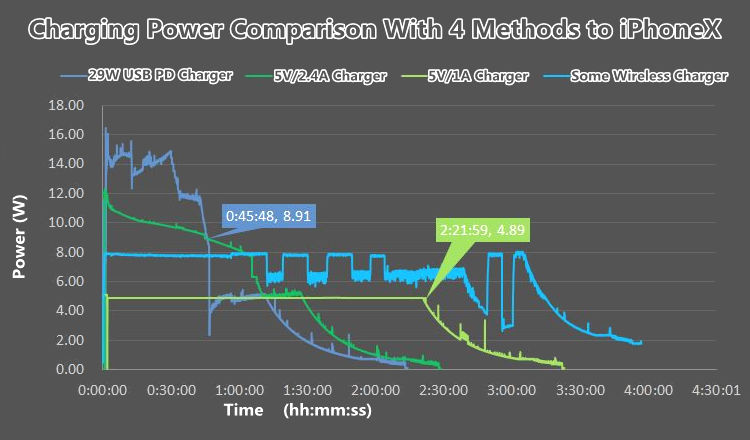
In fact, 5V 2A is Qualcomm‘s Quick Charge 1.0 technology. Of course, in fact, in order to prevent the charger full load, the general cell phone is limited to about 5V 1.8A. Android phones 5V 2A charging technology has no restrictions and no identification protocol.
Apple not only Lighting cable is certified, the charger is also certified, Apple devices detected non-original charger will limit the current to 5V1A or even 0.5A. This is also a reason why the pirated Apple line charging slow.
We all know that the key to increasing the charging speed is to increase the power of charging. Power (W) = Current * Voltage. The charger first steps down the conventional high-voltage 220V to 5V output to the phone‘s MicroUSB port, and then the phone‘s internal circuitry steps down to about 4.3V to charge the battery. There are a total of two step-down processes here.
Before the charger output voltage is 5V, we think how to improve the current; but when it reaches 5V 2A, the bottleneck comes: the current will increase again will inevitably cause a large number of Micro USB interface and cable can not bear.
At present, the common Micro USB interface and our USB cable, generally speaking, can only ensure safe and efficient transmission at a current of 2A, the current exceeds 2A hardware can not stand.
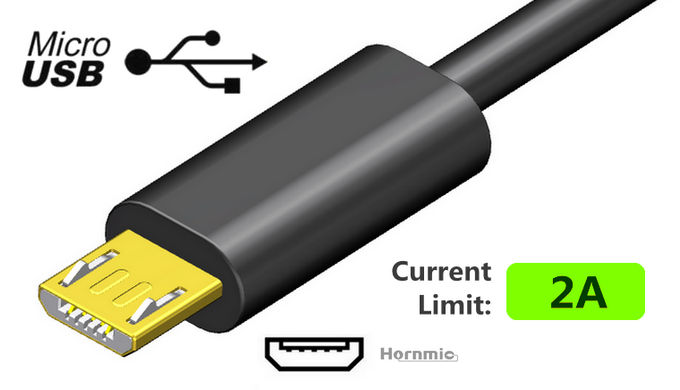
USB3.1 interface and Type-C interface
USB 3.0 ports are made blue to differentiate them from USB 2.0 ports which are black. Currently, ASUS has launched a motherboard equipped with a standard Type-A USB3.1 interface with a blue-green color to distinguish it from USB3.0. Although the USB Association does not specify the color of USB3.1, it is inevitable that the color will be used to distinguish it.
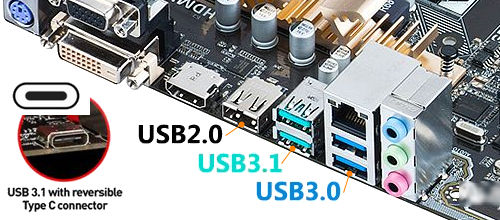
Type-C interface and USB3.1 standard were launched almost at the same time, and the specification of Type-C is indeed made according to USB3.1, so USB3.1 can certainly be made as Type-C type, but Type-C ≠ USB3.1: for example, Nokia N1 tablet uses Type-C interface with USB2.0 specification, while Asus Z97-K uses The standard Type-A USB3.1 interface is used.
|
Comparison of previous generations of USB specifications |
|||
|
Version |
Max. Speed |
Code Name |
Max output current |
|
USB1.0 |
1.5Mbps |
LowSpeed |
500mA |
|
USB1.1 |
12Mbps |
FullSpeed |
500mA |
|
USB2.0 |
480Mbps |
HighSpeed |
500mA |
|
USB3.0 |
5Gbps |
SuperSpeed |
900mA |
|
USB3.1 |
10Gbps |
SuperSpeed+ |
900mA |
Type-C interface has been integrated with DP, HDMI and D-Sub interface. With the high integration of multiple functions and strong performance, we have every reason to believe that Type-C will become the perfect solution to replace many video and data interfaces and unify many interfaces in the future.
Type-C is a groundbreaking interface that can be used on both master and slave devices.
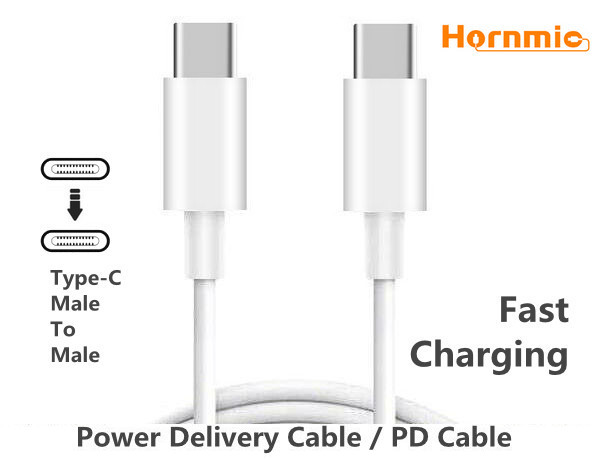
The relationship between TypeC and fast charging
Type C interface has several times the number of contacts than Micro USB interface, which makes it able to withstand a much higher current strength; at the same time Type C adds a step of mutual recognition, which can define itself as a charger or a powered device. In other words USB Type C naturally supports fast charging, and USB Type C losses will be smaller at the same current, and can support bi-directional charging.
TypeC does not mean fast charging, but Type C does not support fast charging is excessive.
The current when charging your phone is not always constant. When your phone is at low battery, the phone will ask the charger to work at full speed to replenish the power, which is called a peak. At this time the charger and the phone‘s buck circuit fires up, charging very fast, but the loss and heat is also very large.
Generally charge to 60% to 80%, according to the different settings of each manufacturer, the phone will send a signal to the charger to reduce the current, in order to protect the battery, reduce losses, reduce heat and other purposes; in this latter stage, the power of charging is significantly reduced, which is often referred to as the Trickle Charge.
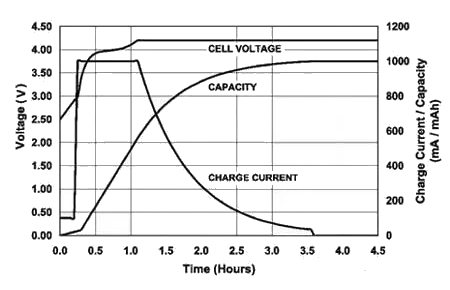
Again, the charging current is controlled by the phone, and the charger has nothing to do with the charger can only passively adapt to the needs of the phone, with same voltage will not damage the phone because the charger power is too high;.
Quick Charge 2.0 can identify the voltage value that can be accepted on the receiving side, so if you can‘t identify it, return it to 5V and charge it slowly.
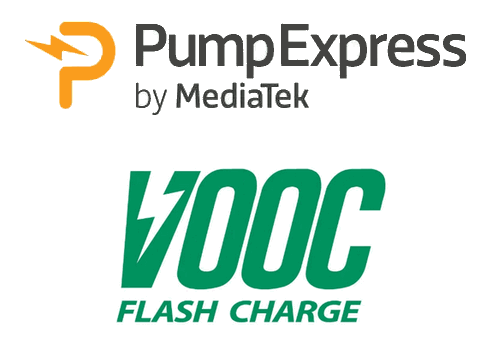
So many manufacturers began to do their own private fast charging protocols. For example, MTK‘s PUMP EXPRESS PLUS, Huawei‘s own identification protocol SCP. But the basic principle is the same, that is to start charging from 5V, and then the charger and the phone identify each other, in the case of current up to 2A to increase the voltage of the charger to the phone‘s USB port. Samsung FastCharge, ASUS cell phone fast charging in fact is the Quick Charge 2.0 variant; and Meizu mCharge is a variant of MTK PUMP EXPRESS PLUS.
So the more low-threshold technology, the easier it is to be copied and bypassed.
However, the specific principles of these fast charging technologies are similar: the charger communicates with the phone and will initially charge normally using 5v; if the phone supports the fast charging protocol, the phone will communicate with the charger for a short time; after the charger receives the correct signal, it starts to output a higher voltage.
Version development of QC
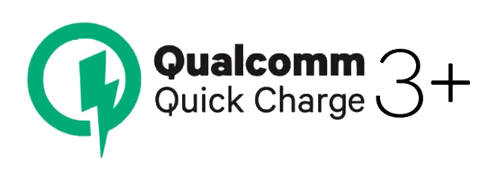
QC1.0: Voltage and current boosted to 5V2A, 40% shorter charging time
QC2.0: Compared to the old standard, QC2.0 epochal change in charging voltage, from maintaining the conventional 5V for many years to 9V/12V/20V, and QC1.0 to maintain the same 2A current to achieve 18W high-power power transmission, and the wire does not require special treatment of the old wire are able to universal.
Increase the voltage, the power is up, but the efficiency is down. Voltage per grade, the efficiency drops about 10%, most of this energy is converted into heat, so 20V voltage grade almost no one uses, only retaining the 5V, 9V, 12V three grades.
QC3.0: In QC2.0 9V/12V voltage based on further subdivision of the voltage file, the use of a unique INOV algorithm, 200mV as a step to set the voltage, as low as 3.6V maximum voltage 20V, and backward compatible with QC2.0. due to the full use of Type-c interface instead of the original MicroUSB interface, the maximum current is also raised to 3A Because of the lower voltage, the efficiency is increased up to 38%, the charging speed is increased by 27%, and the heat is reduced by 45%.
QC4.0: Once again improve the power to 28W, and join the USB PD support. Cancel the 12V voltage grade, 5V maximum output 5.6A, 9V maximum output 3A, and the voltage grade continues to be subdivided to 20mV as a step.
USB PD charging protocol
The USB PD charging protocol, known as USB Power Delivery Specification, was developed by the USB-IF in July 2012.
The USB PD technology is not only strong in charging power with 5 grades 10W/18W/36W/60W/100W, but it is even more powerful because it can achieve two-way charging, which means that two computers can charge each other with a USB cable connection, which is much more advanced than the QC protocol for one-way charging.
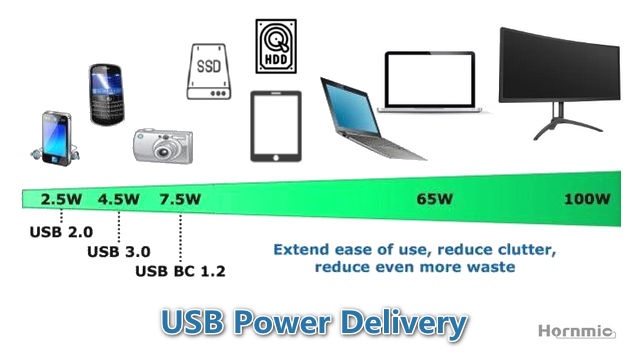
USB PowerDelivery fast charging principle
The USB Power Delivery fast charging specification (Requesting the charger to adjust the output voltage and current by coupling FSK signals on the VBUS DC level) is different from the Qualcomm Quick Charger 2.0 specification because Qualcomm QC2.0 uses different DC voltages on D+ and D- to request the charger to dynamically adjust the output voltage and current to achieve fast charging process.

The difference with QC (Quick Charger):
First of all, Power Delivery is concerned about two or more devices, or even a USB-based smart grid power transfer process, power transfer can be two-way, can be networked, can have a system-level power supply strategy. QC is Quick Charge is only concerned with fast charging, power transmission is unidirectional, does not have the power networking capabilities, does not support other functions in addition to power supply.
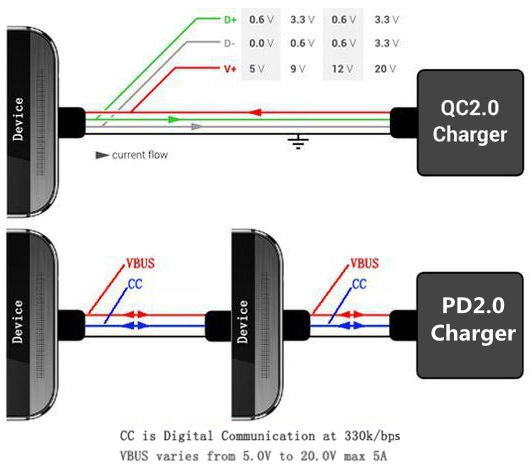
We can see that USB-PD not only brings a variety of forms of interface applications for consumer electronics, but also carries the future of consumer electronics and part of the home appliance power supply management intelligent mission, will be able to better solve the current power supply confusion, a variety of adapters and connection cable serious waste of social resources, pollution of the natural environment.
Another technical route to fast charging: OPPO‘s VOOC flash charging. The high voltage charging technology mentioned earlier is because the current exceeds 2A and the hardware can‘t handle it; so OPPO came up with a simple and brutal solution: transform the hardware from start to finish!
VOOC flash charging has many advantages, and its technical guiding principle is to use high cost for high power and low heat generation. It also has disadvantages: the charger is large, poor versatility and high cost.
Here‘s another key thing:
Does the battery life decrease when the charging input power increases?
The battery has two poles: the positive electrode is a lithium compound and the negative electrode is graphite. Charging and discharging are the interconversion of electrical and chemical energy, and during the movement of lithium ions at the positive and negative electrodes, they are also turning into different compounds. During charging, the lithium ion moves to the graphite carbon layer micropore at the negative electrode; it returns to the positive electrode when it is in the discharge process, at same time power is supplied to external devices.
Ideally, as long as the chemical structure of the positive and negative electrode materials basically does not change and the reversibility of battery charging and discharging is good, the lithium-ion battery can ensure a long time cycle.
Fast charging is mainly to ensure that lithium ions are quickly embedded from the positive electrode and quickly embedded in the negative electrode, which cannot cause the deposition of lithium ions.
However, when the current increases, a layer of semi-permeable film (SEI film) on the graphite surface of the negative electrode will have some rupture, so that the electrode material and electrolyte react with each other, in addition to the temperature increase will also allow the battery internal side reactions to destroy the chemicals on the battery, resulting in a reduction in reversibility, and the battery capacity will continue to decrease.
Lithium battery charging process:

Lithium batteries have a charge/discharge protection circuit, which measures the voltage during the charge/discharge process to determine its state.
The charging current of Li-ion battery is shown in the pink line above. Li-ion battery charging is divided into three stages, which are constant current pre-charging, high current constant current charging and constant voltage charging.
When the voltage is lower than 3.0V, the charger will use 100mA current to pre-charge the lithium battery, which is the CC Pre-charge stage, the purpose is to slowly restore the over-discharged lithium battery, is a protective measure to. Qualified chargers will have this charging stage.
When the voltage of Li-ion battery is higher than 3.0V, it enters the second stage, high current constant current charging stage (CC Fast charge). As the Li-ion battery has been pre-charged in the first stage, its state is already relatively stable. So in the second stage, the charging current can be increased appropriately.
Fast chargers have a "handshake protocol" that coordinates the output voltage and current before charging to ensure the safety of the battery.
So the answer is that when the charging input power is increased, the battery life will not be reduced.
By HornmicLink_Bob Kuo @230918 15:38











